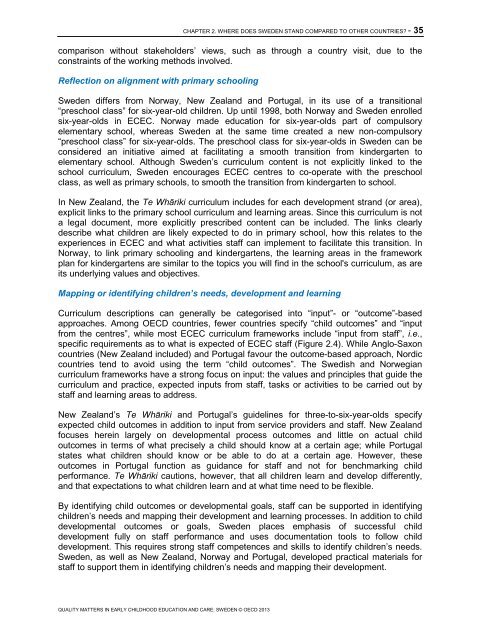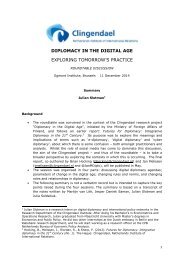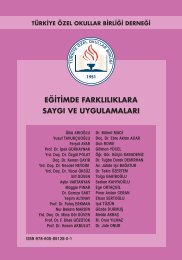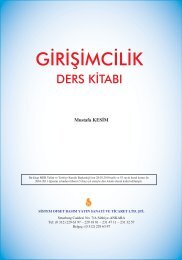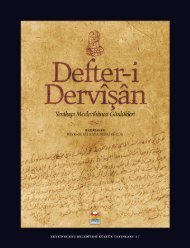SWEDEN%20policy%20profile%20-%20published%2005-02-2013
SWEDEN%20policy%20profile%20-%20published%2005-02-2013
SWEDEN%20policy%20profile%20-%20published%2005-02-2013
You also want an ePaper? Increase the reach of your titles
YUMPU automatically turns print PDFs into web optimized ePapers that Google loves.
QUALITY MATTERS IN EARLY CHILDHOOD EDUCATION AND CARE: SWEDEN © OECD <strong>2013</strong><br />
CHAPTER 2. WHERE DOES SWEDEN STAND COMPARED TO OTHER COUNTRIES? - 35<br />
comparison without stakeholders’ views, such as through a country visit, due to the<br />
constraints of the working methods involved.<br />
Reflection on alignment with primary schooling<br />
Sweden differs from Norway, New Zealand and Portugal, in its use of a transitional<br />
“preschool class” for six-year-old children. Up until 1998, both Norway and Sweden enrolled<br />
six-year-olds in ECEC. Norway made education for six-year-olds part of compulsory<br />
elementary school, whereas Sweden at the same time created a new non-compulsory<br />
“preschool class” for six-year-olds. The preschool class for six-year-olds in Sweden can be<br />
considered an initiative aimed at facilitating a smooth transition from kindergarten to<br />
elementary school. Although Sweden’s curriculum content is not explicitly linked to the<br />
school curriculum, Sweden encourages ECEC centres to co-operate with the preschool<br />
class, as well as primary schools, to smooth the transition from kindergarten to school.<br />
In New Zealand, the Te Whāriki curriculum includes for each development strand (or area),<br />
explicit links to the primary school curriculum and learning areas. Since this curriculum is not<br />
a legal document, more explicitly prescribed content can be included. The links clearly<br />
describe what children are likely expected to do in primary school, how this relates to the<br />
experiences in ECEC and what activities staff can implement to facilitate this transition. In<br />
Norway, to link primary schooling and kindergartens, the learning areas in the framework<br />
plan for kindergartens are similar to the topics you will find in the school's curriculum, as are<br />
its underlying values and objectives.<br />
Mapping or identifying children’s needs, development and learning<br />
Curriculum descriptions can generally be categorised into “input”- or “outcome”-based<br />
approaches. Among OECD countries, fewer countries specify “child outcomes” and “input<br />
from the centres”, while most ECEC curriculum frameworks include “input from staff”, i.e.,<br />
specific requirements as to what is expected of ECEC staff (Figure 2.4). While Anglo-Saxon<br />
countries (New Zealand included) and Portugal favour the outcome-based approach, Nordic<br />
countries tend to avoid using the term “child outcomes”. The Swedish and Norwegian<br />
curriculum frameworks have a strong focus on input: the values and principles that guide the<br />
curriculum and practice, expected inputs from staff, tasks or activities to be carried out by<br />
staff and learning areas to address.<br />
New Zealand’s Te Whāriki and Portugal’s guidelines for three-to-six-year-olds specify<br />
expected child outcomes in addition to input from service providers and staff. New Zealand<br />
focuses herein largely on developmental process outcomes and little on actual child<br />
outcomes in terms of what precisely a child should know at a certain age; while Portugal<br />
states what children should know or be able to do at a certain age. However, these<br />
outcomes in Portugal function as guidance for staff and not for benchmarking child<br />
performance. Te Whāriki cautions, however, that all children learn and develop differently,<br />
and that expectations to what children learn and at what time need to be flexible.<br />
By identifying child outcomes or developmental goals, staff can be supported in identifying<br />
children’s needs and mapping their development and learning processes. In addition to child<br />
developmental outcomes or goals, Sweden places emphasis of successful child<br />
development fully on staff performance and uses documentation tools to follow child<br />
development. This requires strong staff competences and skills to identify children’s needs.<br />
Sweden, as well as New Zealand, Norway and Portugal, developed practical materials for<br />
staff to support them in identifying children’s needs and mapping their development.


